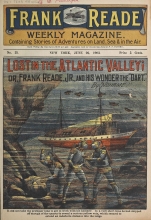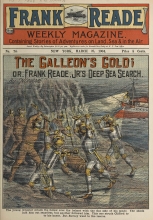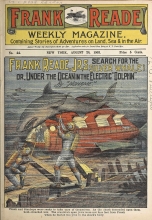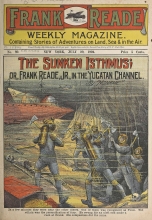Sea Change
Underwater Worlds: Fathoming the Deep
The sea was a vital part of 19th-century life: distant travel, commerce, and the livelihoods of many depended on it. Tales of sea voyages, both fact and fiction, were immensely popular. As scientists explored the depths of the oceans, however, stories began to take place not just on the sea, but in it.
In the early 1800s, scientists believed the deep sea simply could not sustain life. Knowledge of the oceans had largely been limited to shores and shallow waters, but the mid-19th century saw the start of our exploration of this immense underwater world. Technological improvements to submersible vessels and diving gear helped make the seas more accessible. The bold plan to lay a telegraph cable across the Atlantic Ocean made understanding the ocean floor essential, and helped drive deep-sea exploration further.
Happy, truly, is the naturalist. He has no time for melancholy dreams. The earth becomes to him transparent; everywhere he sees significancies, harmonies, laws, chains of cause and effect endlessly interlinked, which draw him out of the narrow sphere of self-interest and self-pleasing, into a pure and wholesome region of solemn joy and wonder.
—Charles Kingsley, Glaucus, or, The Wonders of the Shore, 1859
Ocean Gardens: The History of the Marine Aquarium
London, 1857
Interest in sea life found its way into the home in the 1850s as the first aquariums (or “aqua-vivariums”) appeared. Having a miniaturized version of the ocean floor at home became a mid-19th century fad. The first public aquarium opened in 1853 in London. Purveyors of aquatic plants and animals catered to aquarium enthusiasts. Books offered advice to enthusiasts on creating and maintaining their indoor “ocean gardens.”
French novelist Jules Verne’s 1870 book, Vingt Mille Lieues Sous les Mers (Twenty Thousand Leagues Under the Seas in English), appealed to the public’s growing fascination for the deep, blending undersea adventure with marine biology and technological innovation. The enigmatic, troubled Captain Nemo takes his captive guests through the world’s oceans in his marvelous submarine, teaching them, and the reader, a thing or two on the way.
You are going to travel through a wonderland. ... I am going to embark on a new underwater tour of the world—who knows, perhaps the last?—and revisit everything I have studied on my many travels; and you will be my study companion. Starting today, you will enter a new element, you will see what no man has ever seen before...; and our planet, through my efforts, will deliver up its last secrets.
—Captain Nemo to Dr. Aronnax, in Jules Verne's Twenty Thousand Leagues Under the Seas
Three years prior to publishing his novel, Verne visited the Paris Exposition of 1867 where he saw a model of the missile-like French submarine le plongeur, the first to be propelled on its own power. It inspired the Nautilus, Captain Nemo’s far more effective but wholly fictional ship, which shares its name with the early human-powered submarine designed for France by American Robert Fulton in 1800.
German-born Augustus Siebe's improvements to diving helmets in the 1830s resulted in the first effective and commercially successful closed diving helmet and suit, forerunner of the version used today. His invention revolutionized the safe salvaging of sunken ships and underwater engineering, enabling many of the major building projects that characterized the 19th century. Frenchman Joseph-Martin Cabirol's suit, based on Siebe's but with additional innovations, won a medal at the 1867 Paris Exposition.

|

|

|
Illustrated and Descriptive Catalogue: A. Siebe, Inventor of the Close Diving Dress
London, ca. 1870
Verne includes many other instances of inspiration from the scientific events of his time. At the beginning of Twenty Thousand Leagues, Dr. Aronnax sets off in a search for what reports indicate is a terrifying sea monster, only to find the culprit is in fact Captain Nemo in his submarine. Such sightings gripped the public in the mid-1800s. Famed British scientist Richard Owen debunked this 1848 sighting, which was widely reported in the press, declaring it most likely to be an elephant seal, but the public's fascination persisted.

|

|
The Illustrated London News, October 28, 1848
Courtesy Princeton University Library
Could the waters of the Atlantic be drawn off... it would present a scene the most rugged, grand, and imposing. The very ribs of the solid earth, with the foundations of the sea, would be brought to light, and we should have presented to us at one view the empty cradle of the ocean...
-Matthew Fontaine Maury, The Physical Geography of the Sea, 1855
Matthew Fontaine Maury, superintendent of the U.S. Naval Observatory, turned to the practical experience of mariners, using logs and charts from naval and whaling vessels to compile critical data on ocean currents, winds, and more. His extensive research included efforts to chart the Atlantic Ocean floor, and was the first comprehensive oceanographic study made. Understanding the sea through ships' records became an international effort, and earned him the nickname "Pathfinder of the Seas." Maury published his Physical Geography of the Sea to a wider audience, introducing the public, in frequently lyrical prose, to what was now known about the mysterious underwater world. Jules Verne kept a copy at hand when writing Twenty Thousand Leagues, even basing whole passages on Maury's influential book.

|

|
The Physical Geography of the Sea
London and New York, 1855
Gift of the Burndy Library
Maury's work had a role to play in one of the greatest engineering feats of the 19th century. In 1854, New York financier Cyrus Field began pursuing a plan to connect North America and Europe with a telegraph cable across the Atlantic Ocean floor. Samuel Morse and other innovators tinkered with a telegraph system in the 1830s and ‘40s, and in 1844, the first message was sent from Washington, D.C., to Baltimore, Maryland. Cross-Atlantic communication was still limited to being transported slowly via ship. The transatlantic telegraph cable was one of the era's most ambitious engineering efforts. The project was challenged by repeated failures and technical troubles, but 12 years and five attempts later, a cable was successfully laid across the Atlantic in 1866.
Samples of the ocean floor were examined to reassure investors that it was a safe resting place for the undersea cable. These samples indicated a firm and stable bed, consisting mostly of the shells of minute creatures then called infusoria. The slides below are samples of fossil shells from near Barbados, and from a sounding taken at 2050 fathoms. The initials "CF" at right are almost certainly those of Cyrus Field.
In 1858, engineers connected a transoceanic cable for the first time. Celebrations ensued on both sides of the Atlantic. New York’s Tiffany & Co. purchased surplus cable and converted it into souvenirs, umbrella handles, and charms. But when the cable failed after mere weeks, the public’s enthusiasm turned to disappointment. Eight years later, the goal was finally achieved: America and Britain were connected by cable across the Atlantic ocean floor, thanks to Isambard Kingdom Brunel's ship The Great Eastern, five times larger than any other vessel afloat. The transatlantic cable shrank the time it took to send a message between continents from ten days to mere minutes, and stirred a new interest in deep-sea oceanography. The public was gripped by the historic event, following the events in newspapers, and buying commemorative books which recounted the saga of the cable laying.
R. M. Ballantyne, a prolific author of adventure novels for young people, saw the dramatic potential in the story and penned The Battery and the Boiler, retelling the story of the laying of the Atlantic cable. The Atlantic cable makes a cameo appearance in Verne's novel as well.

|

|

|
The Battery and the Boiler, or Adventures in the Laying of Submarine Electric Cables
London, 1883
Gift of the Burndy Library
In the early 1900s, the Frank Reade Weekly Magazine, "containing stories of adventures on land, sea & in the air," regularly pitted its inventor hero and his companions clad in diving suits against undersea foes, and showcased technologically imaginative deep-sea vessels, and fantastic undersea creatures. Fiction had taken to the seas as science did, with adventures in undersea settings persisting into the 20th century and beyond. Though much has been learned since the early 19th century, there is still a great deal left to discover about the ocean's depths.
39088017999145_001crop.jpg

39088017999574_001crop.jpg

39088017999194_001crop.jpg

39088017999582_001crop.jpg

New York, 1903-1904
Gift of the Burndy Library















![Jules Verne, Vingt mille lieues sous les mers [Twenty thousand leagues under the seas] Paris, 1890s](/sites/default/files/styles/large/public/ch5_g5-1_39088010909489_001crop.jpg?itok=h1mq3mns)



![Alfred Edmund Brehm, Brehms Tierleben: allgemeine Kunde des Tierreichs [Brehm's life of animals: general knowledge of the animal kingdom] Leipzig; Vienna, 1890–1893](/sites/default/files/styles/large/public/brehmstierleben10breh_orig_0320crop.jpg?itok=h1mq3mns)
![Jules Verne, Vingt mille lieues sous les mers [Twenty thousand leagues under the seas] Paris, 1890s](/sites/default/files/styles/large/public/g5-4_39088010909489_003detail.jpg?itok=h1mq3mns)









![Ernst Haeckel, Kunstformen der Natur [Art Forms in Nature] Leipzig and Vienna, 1899-1904.](/sites/default/files/styles/medium/public/sil33-115-39_haeckelcrop2.jpg?itok=h1mq3mns)








